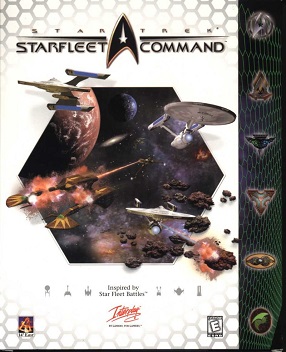
Star Trek: Starfleet Command is a computer game based on the table-top wargame Star Fleet Battles. It was developed by 14° East and Quicksilver Software and published by Interplay Entertainment. It was released in 1999 for Microsoft Windows. It simulates starship operations, ship-to-ship combat, and fleet warfare in the Star Trek universe. An expanded version was released in 2000 titled Star Trek: Starfleet Command - Gold Edition. It includes the latest patch and all the missions that were downloadable from the official website.

Panzer General is a 1994 computer wargame developed and published by Strategic Simulations Inc. (SSI). It simulates conflict during World War II. The designers of Panzer General were heavily influenced by the Japanese wargame series Daisenryaku.

Falcon 4.0 is a combat flight simulation video game developed by MicroProse and published by Hasbro Interactive in 1998. The game is based around a realistic simulation of the Block 50/52 F-16 Fighting Falcon jet fighter in a full-scale modern war set in the Korean Peninsula.

Red Baron II is a video game for the PC, developed by Dynamix and published by Sierra On-Line. It is the follow-up to the flight simulation Red Baron, released in 1990. Red Baron II was released in December 1997. A patch was released in 1998 that added support for 3D acceleration and renamed the game to Red Baron 3D. Red Baron 3D was also released as a retail product.

Dangerous Waters, also known as S.C.S. Dangerous Waters, is a 2005 naval warfare simulation game developed by American studio Sonalysts Combat Simulations. It was released for Microsoft Windows in 2005, and on Steam on February 7, 2006.

Pacific General is a computer wargame depicting famous battles of the World War II Pacific campaigns. It was published by Strategic Simulations in 1997 using the same game engine of the earlier and successful Panzer General for Windows 95. It was re-released on GOG.com in May 2015.
Combat flight simulators are vehicle simulation games, amateur flight simulation computer programs used to simulate military aircraft and their operations. These are distinct from dedicated flight simulators used for professional pilot and military flight training which consist of realistic physical recreations of the actual aircraft cockpit, often with a full-motion platform.
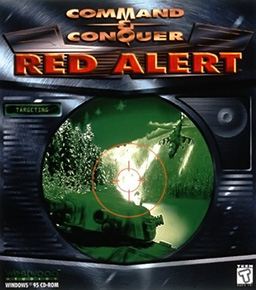
Command & Conquer: Red Alert is a real-time strategy video game in the Command & Conquer franchise, developed and published by Westwood Studios in 1996. The second game to bear the Command & Conquer title, Red Alert is the prequel to the original Command & Conquer of 1995, and takes place in the alternate early history of Command & Conquer when Allied Forces battle an aggressive Soviet Union for control over the European mainland.
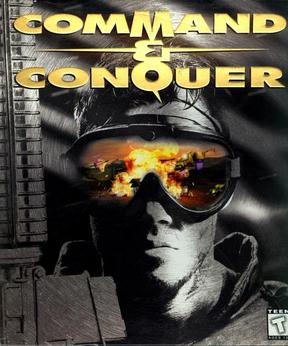
Command & Conquer is a real-time strategy video game developed and published by Westwood Studios in 1995. Set in an alternate history, the game tells the story of a world war between two globalized factions: the Global Defense Initiative of the United Nations and a revolutionary militant organization called the Brotherhood of Nod, led by the mysterious Kane.

AH-64D Longbow is a realistic combat flight simulator of the AH-64D Apache Longbow attack helicopter. Released on June 3, 1996, for the PC, this simulation was developed at Origin Systems. AH-64D Longbow was the second simulator released under the Jane's Combat Simulators line from Electronic Arts.

Achtung Spitfire! is a 1997 computer wargame developed by Big Time Software and published by Avalon Hill. It is a turn-based air combat game taking place during the early half of World War II, including fixed-wing aircraft, air battles and operations by Luftwaffe, Royal Air Force and French Air Force in 1939–1943.

European Air War is a combat flight simulator developed and published by MicroProse and published for Microsoft Windows in 1998. It is a sequel to 1942: The Pacific Air War. It simulates the Battle of Britain, and the Allied Air offensives in Western Europe during World War II in 1943–1945.

MechWarrior 3 is a vehicle simulation game, part of the MechWarrior series. It featured a new 3D accelerated graphics engine at the time of its release. The game contains over 20 missions, with access to 18 different mechs. A novelization called Trial Under Fire was written by Loren L. Coleman.

Hind is a combat flight simulation game released by Digital Integration in 1996 for MS-DOS compatible operating systems and Microsoft Windows. It is the successor to Apache.
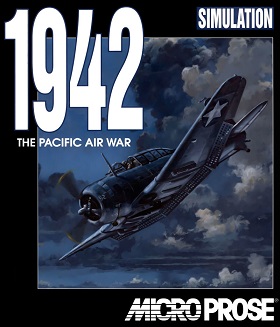
1942: The Pacific Air War is combat flight simulation developed and published by MicroProse for the PC on the DOS operating system in 1994. It is based on the U.S. and Japanese Pacific War conflict from 1942 to 1945. An expansion pack, 1942: The Pacific Air War – Scenario, was released in 1995. A sequel, European Air War, was released in 1998. Tommo purchased the rights to 1942 and digitally publishes it through its Retroism brand in 2015.

People's General is a turn-based computer wargame developed by Strategic Simulations, Inc (SSI). It was released in September 1998 in North America and Europe. The game focuses on early 21st century warfare in Asia. People's General, or PeG as it is commonly known, followed SSI's successful 5 Star General Series of World War II war games and their sequel, Panzer General II (PG2). It uses the same game dynamics as these earlier games—turn-based movement & fighting with military units on a hex based map. PeG uses substantially the same "Living Battlefield" game engine as PG2 but features higher quality graphics and many new features.

Jane's F-15, also known as simply F-15, is a combat flight simulator video game developed and released by Electronic Arts in 1998 for the PC. It models the McDonnell Douglas F-15E Strike Eagle. EA's 2000 Jane's F/A-18 used an improved version of F-15's game engine.

Longbow 2 is the sequel to Jane's AH-64D Longbow from Jane's Combat Simulations. The game was developed by Origin Systems with executive producer Andy Hollis on board, and released by Electronic Arts on November 13, 1997.
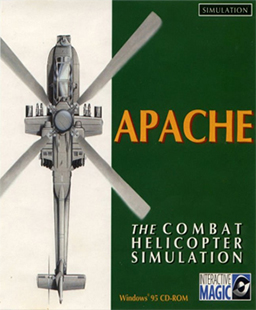
Apache is a video game released by Digital Integration in 1995 for DOS and Macintosh. The game is a combat flight simulation of the American AH-64D Apache Longbow helicopter. A successor, Hind, was released in 1996.

Strategic Command 2: Blitzkrieg is a grand strategy computer game developed by Canadian studio Fury Software, and published by Battlefront.com in 2006. The second game in the Strategic Command series, Blitzkrieg is a turn-based strategy set in World War II, focusing on the European Theater. The player controls all of either Axis or Allied states.




















